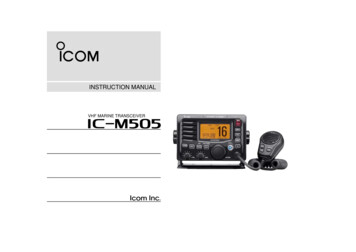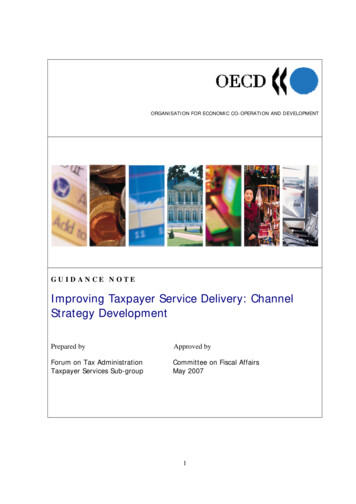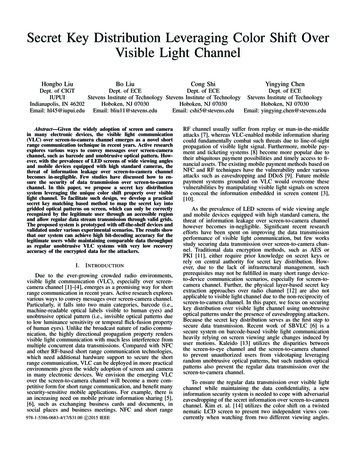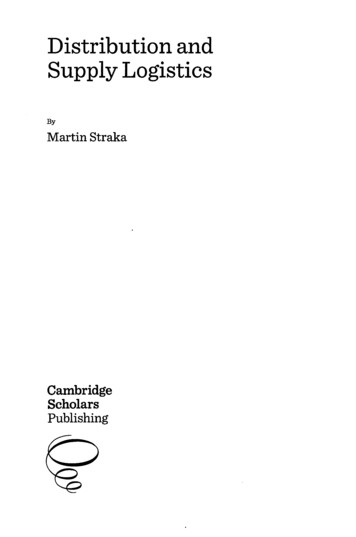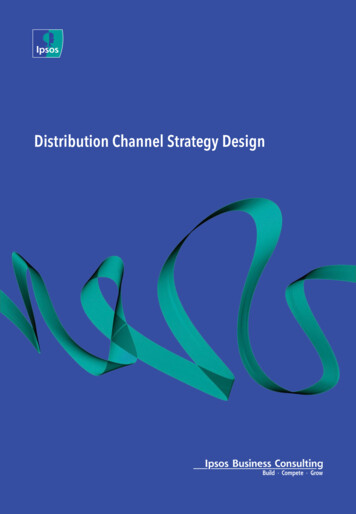
Transcription
Distribution Channel Strategy Design
contentsMarket evaluation3Distribution evaluation12Company evaluation14Key insights and suggested distribution model16Appendix22This paper should be read in conjunction with Ipsos’ Research Note “Achieving Successful Distribution inEmerging Markets”You can download the publication from our web site nsCONTACT US Markus SchererSenior Manager, Chinamarkus.scherer@ipsos.comRESEARCH AND CONSULTING FROM IPSOSA leader in fact-based consulting, Ipsos is trusted by top businesses, government sectors and institutions worldwide. We support domestic andinternational businesses using our fact-based market analysis, as they endeavour to Build, Compete and Grow in emerging and developed marketsglobally.Having opened our first office in 1994 in Hong Kong, Ipsos Business Consulting is immensely proud of its unique Asian heritage. Over the years wehave steadily expanded across the Asia Pacific into Europe and the USA, and recently opened our first office in Africa. We have grown from being anAsia Pacific market intelligence company to become an integral part of the Ipsos global network, with a presence in 85 countries around the world.Ipsos Business Consulting continues to support clients by providing practical advice based firmly in the realities of the market place. With over 19years experience we offer clients the best geographical coverage and solid experience across the region.For more information on our consultancy services, contact consulting.bc@ipsos.comOctober 2013The information contained herein is of a general nature and is not intended to address the circumstances of any particular individual or entity.Although we endeavour to provide accurate and timely information, there can be no guarantee that such information is accurate as of the dateit is received or that it will continue to be accurate in the future. No one should act upon such information without appropriate professionaladvice after a thorough examination of the particular situation. 2013 Ipsos. All rights reserved. Contains Ipsos’ Confidential and Proprietary information and may not be disclosed or reproduced without theprior written consent of Ipsos.www.ipsosconsulting.com
Case study – Distribution channel strategydesignThe client company is an American automotive care and maintenance products manufacturer. Its two major brands are among the mostrecognised auto care appearance and fuel additive brands in the world. Brand A’s product line consists of protectants, wipes, tyre andwheel care products, glass cleaners, leather care products and washes designed to clean, shine and protect interior and exteriorautomobile surfaces. Brand B’s product line includes oil and fuel additives, functional fluids and automotive appearance products. Theclient’s brands target the car maintenance and beauty segment.The company is a global business generating net revenue of US 300m with products available in more than 40 countries. It is arelatively new player in the Chinese market and sells its products under the two above-mentioned brand through a single distributor.The client recently opened an office in Shanghai in order to establish an in-country presence. As of 2011, combined sales of the client’sproducts in China were 1.5m yuan (approximately US 240,000).Ipsos Business Consulting was commissioned to conduct market research of the Chinese automotive maintenance and beauty market inorder to provide the client with a comprehensive market entry strategy.1 Market evaluation1.1 Market analysisChina's overall automotive maintenance and beauty segment was estimated at almost 10.8bn yuan in 2011, comprising 6.5bn yuanfor service activities and 4.3bn yuan of product sales. It posted steady annual growth of more than 20% each year from 2009 to 2011(see Figure 1). Ipsos Business Consulting forecasts this growth trend will continue in the near term.Market size of maintenance & beautysegment 2011Unit: CNY millionMarket size & growth rate 2009-201116,000.014,000.0Unit: CNY eGrowth Rate: 00.05.0%0.00.0%2009Service value40.0%Product value20102011Overall market value2013(F)Growth rateFigure 1 - Market size of China's maintenance and beauty segmentFuel additives, car air fresheners and accessories are the top three product categories by sales value in China and account for about 60%of total market share (see figure 2). At the other end of the spectrum oil additives, protectants and wipes represent just one per cent.Individual product categories drive the segment’s development. Annual growth rates for cleaning products are very high, with generalaccessories growing 23%, washes 20%, cleaners and degreasers 22% and wipes 25%. Beautifying products show similar trends for themost part. The substantial market for air fresheners is expected to grow 30%, wax and polish 25% and the wheel and tyre segment15%, with protectants trailing at 11%. The performance of maintenance products varies slightly with fuel additives and functional fluidsconsulting.bc@ipsos.comIPSOS BUSINESS CONSULTING Distribution Channel Strategy Design3
demonstrating strong growth potential (30% and 35% respectively) while growth in oil additives has almost stalled with sales forecastto rise a mere 2% this year.Product value by client’s product portfolio 2011Unit: CNY million1,500.01,250.0Wheels &tyres, 7.0%Wax & polish,5.6% Others, 1.0%Cleaner °reaser,7.4%1,200.0900.0720.0600.0Fuel additives,28.8%Washes, r air accessories functionalfreshenerfluidswashesCar airfreshener,16.6%13.28.0cleaner & wheel & tire wax & polish oil additives protectantdegreaserwipesFigure 2 - Market size by client's product portfolioThe number of passenger vehicles varies greatly from region to region as shown in figure 3. The vast majority of China's passengervehicles are found in regions located along the eastern seaboard. Western provinces had less than one million units, according to 2011figures. The top six provinces, which are all located along the east coast, account for more than 47% of the total passenger vehiclemarket by volume. Central regions account for about one-quarter of the market share with the vast western provinces chalking up just8%.Unit: Million866.0Number of passenger vehicles by province in 20115.54.5 gQinghai200.8 0.8 0.70.5 0.30.3 0.2 ngdongFigure 3 - Existing passenger vehicle units by provincesIpsos Business Consulting conducted a social listening study which garnered further insights on end consumer location. It analysed themost popular online forums and internet sites related to China's automotive aftercare market for mentions of certain product groupsand car maintenance products as well as identifying where forum users lived. More than half of the content was posted from sevenprovinces/municipalities, namely Guangdong, Jiangsu, Beijing, Shandong, Hebei, Zhejiang and Shanghai. These findings are in linewith other analyses of the passenger vehicle market.Figures for new private vehicle sales by province from 2006 to 2011 (see figure 4) show the mid-west enjoys higher growth rates ofmore than 35%, when compared to more mature markets in east China where growth has slowed to around 25% due to higher levels ofdevelopment and increasingly congested traffic. While the volume of sales in the mid-west is lower than in traditional markets, theregion is evolving into an area of increasing importance for companies, especially in terms of future growth potential.consulting.bc@ipsos.comIPSOS BUSINESS CONSULTING Distribution Channel Strategy Design4
China new Passenger Vehicle sales 2006 - 2011 CAGR(%) by province50%45%43% 43% 42%41% 40%38% 37% 37% anChongqingAn’huiJiangxiHunan30-35%25-30% 25%Figure 4 - Passenger vehicle sales growth rates by provincesChina's maintenance and beauty segment comprises nine core after-market channels: large and small workshops, fast fitters, beautyshops, 4S-shops (sales, spare parts, service and survey), gas stations, accessory shops, supermarkets and online shops. Large and smallworkshops, as well as fast fitters, are primarily focused on the independent aftermarket.Large workshops often have fixed corporate clients. Repair services are the key driver in this channel where beauty and maintenanceonly plays a minor role in the business. Small workshops, which rarely belong to a chain or have a brand name, provide simplemaintenance, car wash and beauty services. Fast fitters are mostly independently owned and operated, or local chain shops, focusingon fast-fit services such as filter, engine oil and tyre replacement. The main business of beauty shops is automotive beauty and beautyrelated services. A franchise model is becoming common practice for this type of shop. 4S-shops are authorised by original equipmentmanufacturers (OEM) like Audi or Shanghai Volkswagen and offer services such as car sales, repair and maintenance. Gas stationsproved to be an interesting case during this study as they sell fuel-additive products in addition to their bread-and-butter refuellingbusiness. Accessory shops mainly sell “do-it-yourself ” (DIY) retail products, some also offer car wash and simple repair services. Suchbusinesses are increasingly combining with fast fitter or beauty shops to extend their service offering.Supermarkets and online retailers are significant emerging sales channels for automotive beauty and maintenance products. Thesechannels tend to concentrate on consumer-focused DIY products as they both operate exclusively in the retail space. Online channelscan be either officially authorised shops on Tmall.com (China’s largest online B2C platform for branded goods) or an online portal fordistribution firms who sell other manufacturer’s products. Store numbers and trends vary greatly from channel to channel as China andits automotive aftermarket continue to develop and evolve.Traditional workshops are either stagnant or declining, providing a stark contrast to the boom in newer channels which continue to risein popularity. Smaller workshops are falling by the wayside as they cannot provide the diverse range of services demanded by mostcustomers these days. They also lack the quality provided by other channels. As a result, many smaller workshops are transforming intofast fitter and beauty shops which are proving more resilient to the changes in the market even though their numbers are alsodeclining, all be it at a slower rate.Large workshops are also being affected by the changing face of the auto aftercare market. The segment is currently in stasis, with thenumber of stores remaining roughly the same as it was in 2009. Fast fitters, beauty shops and 4S-stores exhibited the fastest growthfrom 2009-11 with 20%, 25% and 33%, respectively. Their higher-end position increasingly makes them a key part future growth plansfor companies operating in the sector.Gas stations have not been analysed in terms of their quantitative development. The lack of exact figures for the number ofsupermarkets prevents detailed trend analysis. There was also little or no concrete data for the other channels. Accessory shops, forexample, often exist in combination with beauty shops or fast fitters. The nature of online shops makes it difficult to break them downinto specific end channels. What can be said, thanks to a qualitative assessment, is that both accessory shops and online channels areexpanding rapidly.consulting.bc@ipsos.comIPSOS BUSINESS CONSULTING Distribution Channel Strategy Design5
into specific end channels. What can be said, thanks to a qualitative assessment, is that both accessory shops and online channels areexpanding rapidly.Table 1 provides an overview of the different end channels.ChannelStores (est 2011)Growth (no. of stores )Small workshops100,000-12%Large workshops60,0000%Fast fitters24,000 20%Beauty shops50,000 25%4S-stores20,000 33%Gas stations100,000/Accessory shops/Emerging channelOnline shops/Rapid expansionSupermarkets//Table 1 - End channel sales points and trends [1]Ipsos Business Consulting did not conduct a general competitive environment analysis, it instead focused on in-depth analysis ofspecific competitors which were identified together with the client. All foreign brands active in the Chinese market today are seen asthe closest competitors. Section 1.3 provides detailed analysis of these companies with section 2.2 focusing on their distributionstrategies.1.2 Channel structureDistribution layersThe Chinese automotive beauty and maintenance product market has a moderate number of layers between manufacturers at the topand consumers at the bottom. Products are sold directly to end consumers (car owners) via e-commerce channels, as well as tonumerous types of repair and maintenance shops (workshops, fast fitters, beauty shops, 4S-shops, gas stations and accessory shops)where they are used to service customers’ cars or those displayed for sale purposes. Traditionally, the majority of product sales havebeen made through repair and maintenance channels as the DIY market in China is underdeveloped compared to the US and Europe.Manufacturers are both local Chinese companies and foreign firms, the latter of which imports most of their products. Foreignmanufacturers do not usually have a physical presence in the Chinese market, instead they typically work through one to a few generaldistributors. However, general distributors vary greatly in the capacity, quality and penetration of their distribution. A typical modeluses tier-1 dealers or city-level dealers to access most end channels while selling direct to supermarkets and flagship stores onTmall.com (see figure 5).In a few cases, foreign manufacturers operate headquarters and branch offices in China and sell to tier-1 dealers directly without usingan intermediate general distributor. They sell to all end channels through distributors save for supermarkets, which are theresponsibility of branch offices in each respective region, and flagship stores on Tmall.com which is dealt with by the headquarters.Figure 5 gives an overview of these approaches.consulting.bc@ipsos.comIPSOS BUSINESS CONSULTING Distribution Channel Strategy Design6
CACBCCFlagship storeat Tmall.comCDManufacturersBranchofficesGeneral distributorsDistributorsTier-1 dealers(provincial level)Sales channelsSupermarkets4S shops,workshops,fast-fittersAutoparts cityCitydealersBeautyshopsOnlineshopsNote: 1) Auto parts city includes wholesalers and automotive accessory shops2) Dashed arrows indicate less common connectionsFigure 5 - Layers in Chinese maintenance and beauty segmentEnd channel analysisEnd channels have been analysed according to their share of product sales and as a proportion of the total value of products flowingthrough them. This, combined with the number of sales points within each channel, helped the client company focus on essential andimportant channels that should be focused on. Only seven of the 11 product groups within the client’s product portfolio were analysed– washes, cleaners and degreasers, accessories, wax and polish, wheels and tyres , protectants and fuel additives. The remaining fourproduct categories were not included in the analysis because they were mostly distributed online (air fresheners) or through gasstations (oil additives and functional fluids).Figure 6 provides a comprehensive overview of the 2011 sales value distribution between the seven analysed product groups by endchannel. Gas stations were the main driver of overall sales value but only carried one of the seven products (fuel additives) while theothers offered multiple productsconsulting.bc@ipsos.comIPSOS BUSINESS CONSULTING Distribution Channel Strategy Design7
3500300013%Small workshops11%2500Large workshops5%Product sales CNYmillion2000Fast fitters14%Beauty shops15004S stores23%Gas stations100050029%04%only productgroup: fueladditivesOthersSales value splitNote: 1) The following end channels are not included: online shops, supermarkets and accessory shops2) The following product groups are not included: functional fluids, air freshener, oil additives and wipesFigure 6 - Sales value distribution by channels (2011)End channel sales value split shows the product value by end channels by year and the average store contribution for each channel byyear. An evaluation of all product groups (outlined in table 2) shows that three channels stand out for their combination of high totalsales value, high average contribution and channel growth: large workshops, beauty shops and 4S-stores.End channelSmallworkshopsLargeworkshopsFast fittersBeautyshops4S storesGas stationsPoints of oduct value:CNY 349.5 million91108594549Cleaner °reaserProduct value:CNY 321.6 76AccessoriesWax & polishWheels & tyresProtectantsFuel additivesAir freshenerProduct value:CNY 613.2 millionProduct value:CNY 242.6 millionProduct value:CNY 306.2 millionProduct value:CNY 13 millionProduct value:CNY 1250 millionP. value: CNY 720 millionMainly sold through online shops, supermarkets and accessory storesP. value: CNY 8 millionMainly sold through beauty shops and accessory storesOil additivesP. value: CNY 18 millionMainly sold through gas stations and 4S storesFunctionalfluidsP. value: CNY 500 millionMainly sold through 4S stores, workshops and fast fittersWipesOthers0,5313730090050Total product value/year (CNY million)401355169431720900118Ø Total POS hannel development/year-12%0% 20% 25% 33%/Table 2 - End channel sales value split (rounded figures)consulting.bc@ipsos.comIPSOS BUSINESS CONSULTING Distribution Channel Strategy Design8
4S-stores account for about 720m yuan with a very low number of stores, just 20,000 across the country. This leads to an average yearlycontribution of 36,000 yuan from each 4S-store. Large workshops and beauty shops contribute sales of 355m yuan and 431m yuan,respectively. With nearly three times as many stores in the Chinese marketplace than 4S-stores, 60,000 and 50,000, each storegenerates average sales of 5,900 yuan per year for large workshops and 8,600 yuan per year for beauty shops. Beauty shops and 4Sstores also boast an impressive expansion rate which suggests sales generated through these channels will continue to increase for theforeseeable future. Ipsos Business Consulting's analysis has identified these three channels as the most important within the Chineseautomotive care and maintenance product market and recommends they are prioritised.Fast fitters may contribute higher point of sales (POS) revenue per year (about 7,000 yuan), however, they are a less attractive overallchannel due to their relatively total product sales of 169m yuan per year – less than half that of large workshops and beauty shops.However, fast fitters are rapidly expanding which makes them worth considering as a second priority.Small workshops are appealing with total product sales of 401m per year. However, with roughly 100,000 stores, this channel featuresa far higher number of sales points than other channels, except for gas stations, rendering it with the lowest POS contribution of allchannels included in the analysis. It is also the only channel to post a decline in sales revenue in recent years and its store numbers areexpected to contract further in the years to come.Gas stations have to be considered separately from other channels as they only sell one relevant product group, fuel additives. Thissingular focus, however, makes gas stations a vital channel for fuel additives as they generate sales of 900m yuan, more than 70% ofthis group's total yearly sales of 1.25bn yuan.Accessory stores were not included in the analysis as they are often combined with other shops.Online shops and supermarkets are emerging as channels for the distribution of DIY products and will play a bigger role in the future.They are not currently conducive to concrete analysis due to online sales being too difficult to assess in terms of total sales value.Competitor analysis, however, found both channels to be important.1.3 Key competitor analysisThe client's main competitors in the Chinese maintenance and beauty market are competitors A, B and C. For the most part they sharethe client’s product portfolio and are similarly positioned in terms of price. Competitor D, however, operates exclusively within the veryhigh-end price segment. Competitor E only sells air fresheners. In terms of price position the client, as a middle- to high-end brand, ismost similar to competitor A. In the market, however, the client is perceived as an exclusively high-end brand since its low-endproducts are priced higher than those of its competitors. Figure 7 gives an overview of the client’s position compared to its directcompetitors.HighMarket rket positionProduct value(2011)AMiddle-highCNY 185 millionBMiddleCNY 269 millionCMiddleCNY 58.7 millionDHighCNY 45 millionEMiddleCNY 15 million8%Market shareFigure 7 - Competitor's market share and positioningconsulting.bc@ipsos.comIPSOS BUSINESS CONSULTING Distribution Channel Strategy Design9
The client is on exactly the same level as competitor A with regards to its maintenance product group. Other competitors cannot becompared because they do not carry this product group. For beautifying products the client is competing in the same price segments ascompetitor A for the wheel and tyre and protectants product lines. In the wax and polish segment the client only operates in the lowerprice range while competing products retail from the same level up to three times the price. The cleaning product group is differentwith the client having a noticeably higher price than the washes products of competitors A and B. The client provides too narrow a pricerange for cleaner and degreaser products. Figure 8 shows the client's pricing compared to its competitors for two product groups.Wheels & tyresUnit: CNY320Wax & polishUnit: gure 8 - Price ranges of competitors for wheel & tyre and wax & polish product groupsconsulting.bc@ipsos.comIPSOS BUSINESS CONSULTING Distribution Channel Strategy Design10
Figure 9 shows the distribution of the competitors’ sales across their respective channels in 2011 with growth rates compared to theprevious year. It is apparent that not all competitors sell to the same channels, this is in part influenced by the fact that each competingfirm defines their channels differently. Judging from the three players with the largest market share (competitors A-C) e-commerce,with its high growth rates, appears to be the channel offering the greatest future potential.Competitor ACompetitor BTotal: CNY 112.3 millionTotal: CNY 92.4 millionGas stations,6% Online shops,Channelsales split2011Channelgrowth rate( 2010-2011)Workshops &fast fitters, 26%OEMauthorisedshops, 10%Competitor C4S shops,10%15%Supermarkets,10%Auto partscity, 33%Auto beautycity, 33%Total: CNY 31 millionOnline, 3%Online shops,25%Beauty shops,10%Autopartscity, 54%Supermarkets, 10%Workshops,15%Beauty shops,22%Online shops: 50%Online shops: 40%Online shops: 15%Supermarkets: 2%Supermarkets: 40%Supermarkets: 10%Beauty shops accessory shops wholesalers: 17%Beauty shops: 30%Beauty shops:15%OEM authorised shops: 70%Accessory shops wholesalers: 20%Fast fitters: 10%Workshops fast fitters: 5%OEM authorised shops workshops fast fitters: 20%Workshops: 15%Gas stations: 3%Competitor ETotal: CNY 16 millionAuthorisedimage shops,63%Total: CNY 8 millionOnline shops,25%Supermarkets,2%OEMauthorisedshops, 10%Channelgrowth rate(2010-11)Fast fitters,5%Accessory shops wholesalers: 20%Competitor DChannelsales split(2011)Supermarkets, 14%Chain fastfitters &wholesalers,58%Online shops,23%Supermarkets,20%Online shops: 10%Online shops: 10%Supermarkets: 10%Supermarkets: 5%OEM authorised shops: 20%Chain fast fitters wholesalers: 10%Authorised shops:30%Note: Each competitor has its own definition of “channel”. Channel share is based on each competitor’s sales revenue, not market product value.Note: Each competitor has its own definition of “channel”. Channel share is based on each competitor’s sales revenue, not market product value.Figure 9 - Competitor sales split and channel growth ratesconsulting.bc@ipsos.comIPSOS BUSINESS CONSULTING Distribution Channel Strategy Design11
2 Distribution evaluation2.1 Types of distributors and distributor managementIpsos Business Consulting's research of distributing firms within this market mostly focused on general distributors used by foreigncompetitors. Sub-tier distributors are always used by general distributors but their exact types, business models, management factorsand frequency were not covered by the scope of the research. City-level distributors, which form the lowest tier of distributors, are toonumerous to enable accurate analysis and therefore remain beyond the scope of this report.General distributors are large nationwide distributing firms operating with logistics and warehouse capabilities. As stockholdingresellers they receive imported goods from suppliers, stock them and distribute them. Some general distributors operate exclusivelywithin a specific industry segment selling only one brand or the brands of one manufacturing company, most carry multiple brands anddistribute a variety of brands with different product lines to different industrial segments. As nationwide operators these distributorsalways use some regional system which typically divides China into six-to-eight territories. They sell directly to supermarkets and otherwholesalers as well as usually setting up a flagship ecommerce store on Tmall.com. General distributors work through a network of subtier dealers to distribute to the remaining channels.Management of sub-tier distributors is quite diverse. A common practice imposes annual sales targets on them to ensure minimumsales through each tier-1 or city dealer. These dealers typically receive bonuses of 1-2% for meeting their targets. Additional financialsupport is provided to sub-tier dealers in a variety of ways including rebates for quick payment processing or supplying them with freeproducts for orders over a certain quantity. Sales and marketing programs include attending exhibitions to promote the client’s brandand develop sales leads as well as sending out free sample products to attract new clients. Manufacturers provide general distributorswith posters and other advertising collaterals some of which are passed on to sub-tier dealers. Some manufacturers also have brandedproduct display requirements that distributors must follow in order to ensure uniform product display across all end channel points ofsale. General distributors also provide technical and sales training seminars and allocate salesmen to their sub-dealers to offer supportand gain feedback.The two types of sub-tier dealers differ mainly in terms of their geographical reach. The first type are tier-1 dealers who operate on aprovincial level, meaning they cover one to a few provinces. They are the “go-to” choice for most general distributors and are easilyavailable in most regions (slightly less in lower tier regions, eg Northwest China). There is not enough information to cluster them bysize or business model but the typical distributor in this market is a simple reseller who stocks the products and goods of its clients.These tier-1 dealers normally obtain products from general distributors or in some cases from the manufacturer’s branch offices. Theirpurchase price ranges from 30-60% of the market retail price. Tier-1 dealers have to meet sales targets set by general distributors or themanufacturer’s branch offices and are often assigned a territory to sell into. It is unusual in this market for tier-1 dealers to be offeredterritorial or brand exclusivity. Tier-1 distributors target available end channels, with the exception of supermarkets, which they eitheraccess directly themselves or through a layer of city-level dealers. Additionally, it is common for tier-1 dealers to run their own onlineshops where they offer their whole product portfolio which includes the manufacturer’s products. This unofficial distribution of brandedproducts limits the manufacturers’ sales through their official e-commerce channels. Tier-1 dealers’ capabilities and competencies tosell to specific end channels were not part of the analysis and are therefore unknown.City dealers are the second type of sub-tier dealers in this market. City dealers are less focused than their larger counterparts and try tosell a large variety of products to cities within their footprint. This category typically includes stockholding resellers and those withoutstock as well as agents working on behalf of upper-tier distributors. They pay more for products from suppliers than tier-1 distributors.Common management practices of city dealers cannot be clustered as they are to great in number and therefore evade analysis in thiscase. Figure 10 provides an overview over the different types of distributors.consulting.bc@ipsos.comIPSOS BUSINESS CONSULTING Distribution Channel Strategy Design12
DistributorTypeGeneraldistributorTier-1 dealer(provinciallevel)City dealerFrequencyDistributor Features Limitedavailabilitydue to size Stockholding reseller Operates nationwide Works with region-basedsystem (6-8 regions) Both single brand (exclusivedistributor not sellingcompeting products) andmulti brand (selling
China's overall automotive maintenance and beauty segment was estimated at almost 10.8bn yuan in 2011, comprising 6.5bn yuan . 4S-shops (sales, spare parts, service and survey), gas stations, accessory shops, supermarkets and online shops. Large and small . A franchise model is becoming common practice for this type of shop. 4S-shops are .



